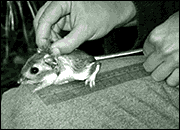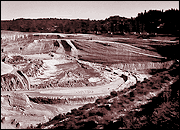
|
 |
 |
Santa Cruz kangaroo ratís decline indicates a plant community
at risk
by Debbie Bulger and Caitlin Bean
The Santa Cruz kangaroo rat (Dipodomys venustus venustus ) never was very widespread
in its occurrence. Historically, it ranged from Belmont, south of San Francisco
through the Santa Cruz Mountains to approximately Corralitos. Where once its range
encompassed much of Santa Cruz County and parts of San Mateo and Santa Clara Counties,
recently it has been found on only one parcel in the Santa Cruz Mountains.
Its habitat and population have diminished at an alarming rate over the last quarter
century.
Named for its hind legs which are well adapted for jumping locomotion, kangaroo
rats are nocturnal rodents more closely related to gophers than to rats. Like
gophers, kangaroo rats have fur-lined cheek pouches perfect for gathering seeds,
their main food. Typically they are found in arid areas where most species do
not need to drink water. However, the Santa Cruz kangaroo rat is unusual in that
it has adapted to living in our temperate climate and actually drinks free water.
There are 23 species or subspecies of kangaroo rats found only in California.
Five of these are listed under the Federal Endangered Species Act. Five additional
species or subspecies are listed as “Species of Special Concern” by
the California Department of Fish and Game. The Santa Cruz kangaroo rat is not
listed as endangered by either the state or the federal government although it
appears to meet the criteria for listing.
It is tottering on the brink of extinction. Not only are its numbers down and
its range contracted, it appears to be suffering from low genetic diversity which
puts its existence at even greater risk. Its relatively long life for a rodent
(four to five years) and slow maturation rate allow for the survival of adults
during droughts. This adaptation does not result in high production of young—a
fact which may have contributed to its decline.
| |
 |
| |
Its unusually long
tail provides the kangaroo rat with balance when jumping.

|
And it is not alone. The kangaroo rat is considered a “keystone” species.
That means that its activities have great influence on the plants and animals
that occupy the same habitat. This effect of the kangaroo rat was documented by
Jim Brown and Ed Heske in 1990 when they published the findings of their 10-year
field experiment in which they excluded kangaroo rats from specific areas in the
Chihuahuan desert. These researchers discovered that absence of kangaroo rats
resulted in a major change in the vegetation cover and the species composition
within the exclosures (i.e., desert shrubland was converted to grassland!). Some
species did not do as well as they would have in the presence of the kangaroo
rat. In other words, kangaroo rats had a role in maintaining a healthy functioning
ecosystem.
Kangaroo rats dig burrows, move seeds around and cache seeds—activities which
are beneficial to other species.
It has been suggested that in California, kangaroo rats are indicators of the
health of the very ecosystem which they inhabit. Like the famous canary in the
coal mine, their decline may be an early warning sign of the decline of entire
natural communities.
The community which the Santa Cruz kangaroo rat inhabits is unusual indeed. These
small, long-tailed rodents live in a plant community called “silverleaf manzanita
mixed chaparral” which is found on inland marine sand deposits. This plant
community is one of only two that comprise the Zayante sand hills ecosystem which
supports not only the Santa Cruz kangaroo rat, but also at least 11 rare plants
and three rare animal species, many found nowhere else in the world.
The Zayante sand hills are characterized by manzanita, including the rare silverleaf
manzanita, ponderosa pine, coyote bush and other chaparral plants. Their soft,
well-drained sand provides an ideal soil for digging burrows, but also make this
area attractive for sand quarrying.
Due to land use decisions over the years, the historically limited and fragmented
amount of silverleaf manzanita chaparral has steadily decreased. Urbanization
has accounted for much of the loss of the historic range of the Santa Cruz kangaroo
rat. In addition, a large portion of the once intact sandhills ecosystem has been
directly destroyed by sand mining operations.
It has been estimated that historically a total of 3,121 acres of this plant community
existed in Santa Cruz County. A 1994 estimate suggested that about 400 acres had
been altered by residential development, 350 acres had been removed for sand quarrying,
and another 400 acres developed as landfills and commercial property. In the nine
years since that estimate, it is likely that the total amount of silverleaf manzanita
chaparral has decreased markedly. The decline of the distribution and numbers
of Santa Cruz kangaroo rats point to that very conclusion.
Other threats to the Santa Cruz kangaroo rat include predation by cats, recreational
uses such as off-road mountain biking and horseback riding, and fire suppression.
Given the fact that the Santa Cruz kangaroo rat has a narrow geographic range,
specialized habitat requirements, and is known to occur only in small populations,
it appears there is a high probability of its becoming extinct in the near future.
For this reason, Caitlin Bean is petitioning both the Federal Government and the
State of California to list this species as endangered.
 |
|
A large portion
of the once intact sandhills ecosystem has been directly destroyed by sand mining
operations.

|
|
It’s all connected
This last half-century has been marked by a passionate effort to save the earth’s
biodiversity, but species continue to slip quietly into oblivion. Why should people
be concerned about the extinction of small mammals such as kangaroo rats, amphibians
such as long-toed salamanders or even insects? The famous biologist E.O. Wilson
wrote, “Each species, to put the matter succinctly, is a masterpiece.”
Each species plays a role in its ecosystem that other species may be dependent
upon. In addition, each species is a source of knowledge and aesthetic pleasure.
However, one of the most compelling arguments to care about these creatures is
that each extinction sends a message that we are fouling our home. What is bad
for nature is almost certainly bad for us. Our efforts to protect these resources
help to insure that future generations will be able to enjoy nature the way we
have.
How you can help:
- Avoid bike and horse riding in the fragile Zayante soils (especially in silverleaf
manzanita chaparral habitat patches).
- Respect trail closures for endangered species management.
- Avoid constructing trails in the highly erosive Zayante soils.
- Support prescriptive fire efforts in maritime chaparral habitats.
- Contribute to local land preservation efforts.
- If you live adjacent to silverleaf manzanita chaparral, please keep your cats
indoors.
- If you have maritime chaparral on your property and would like to know if
it provides habitat for the Santa Cruz kangaroo rat, call Caitlin Bean, 423-2348;
her research is ongoing.
- Contact the Sand Hills Alliance for Natural Diversity (SAND), a group formed
to preserve our rare and unique sandhills habitat and inspire stewardship through
scientific research, public education, and integrated land use planning. SAND
participants come from a variety of backgrounds, and include landowners, biologists,
planners, and other concerned citizens. SAND meets each month to discuss a variety
of sandhills conservation issues. Participants help preserve sandhills habitat,
lead community educational programs, conduct scientific research, and help direct
management for sandhills habitat. SAND advises on many types of sandhills related
projects, providing science-based information for successful conservation. In
the spring, SAND leads guided walks to see the amazing wildflowers of the sandhills.
For more information, contact Jodi
McGraw.
[ top of page ]
|
|
 [an error occurred while processing this directive]
[an error occurred while processing this directive] |

